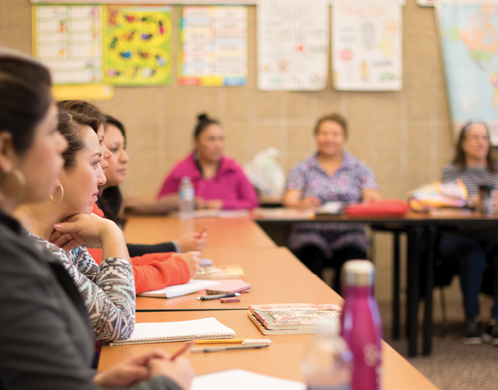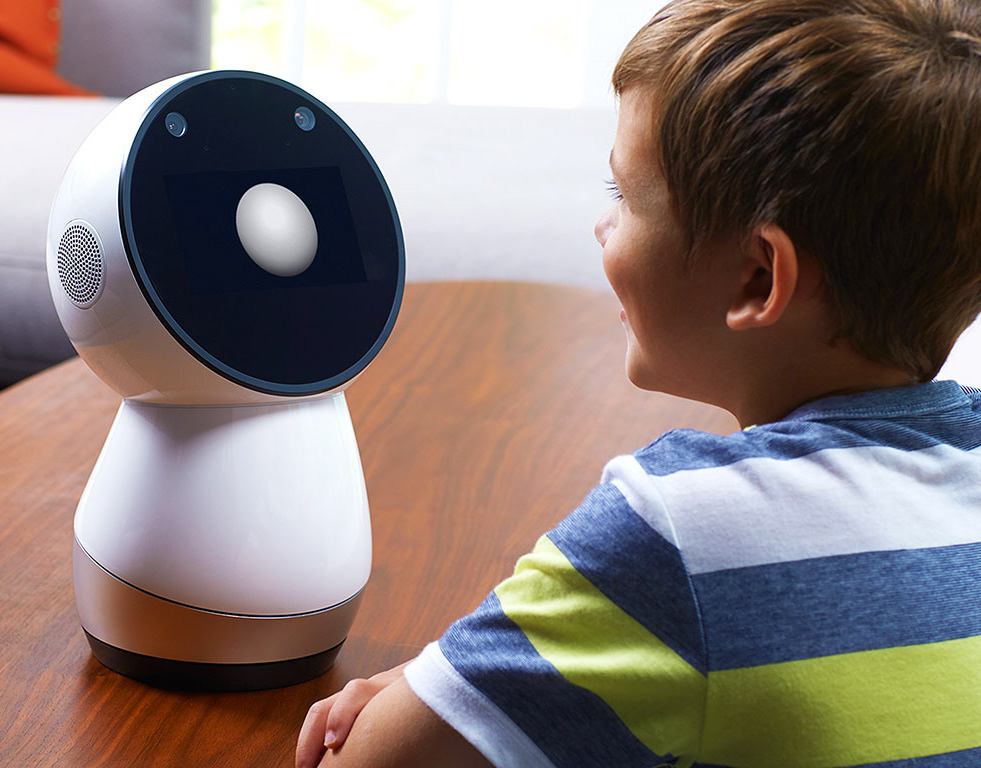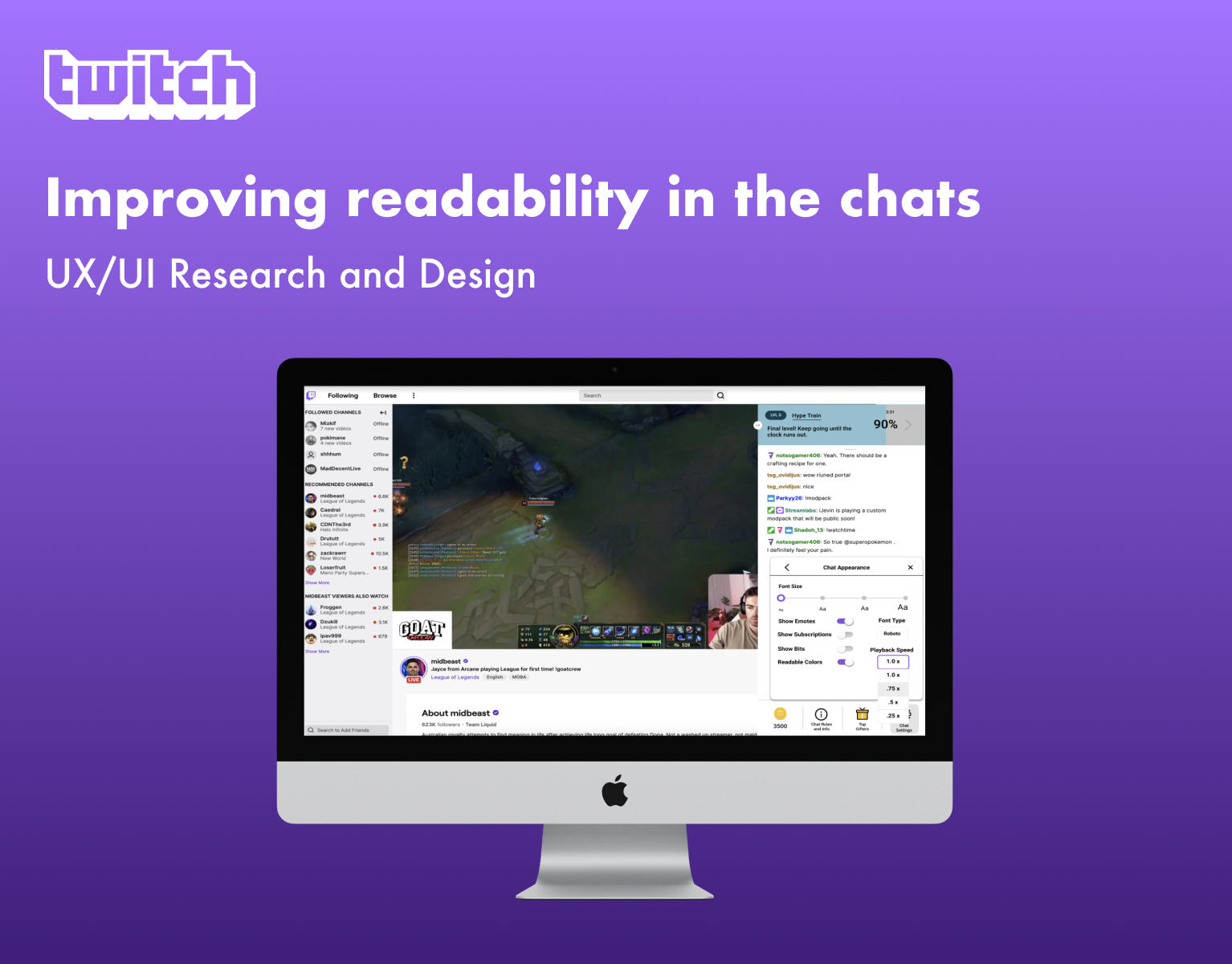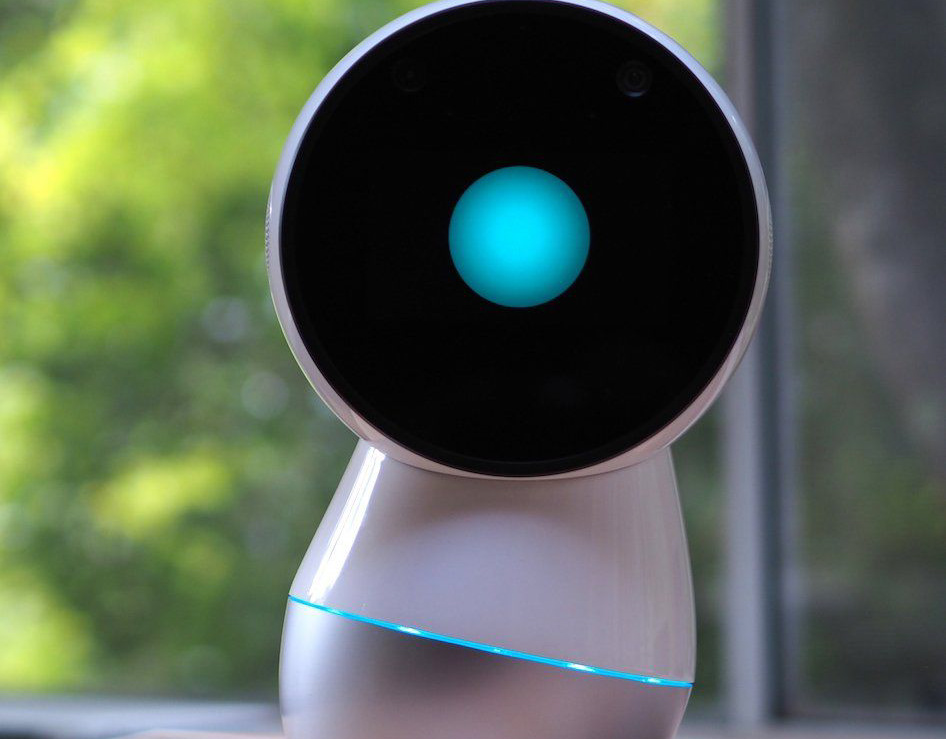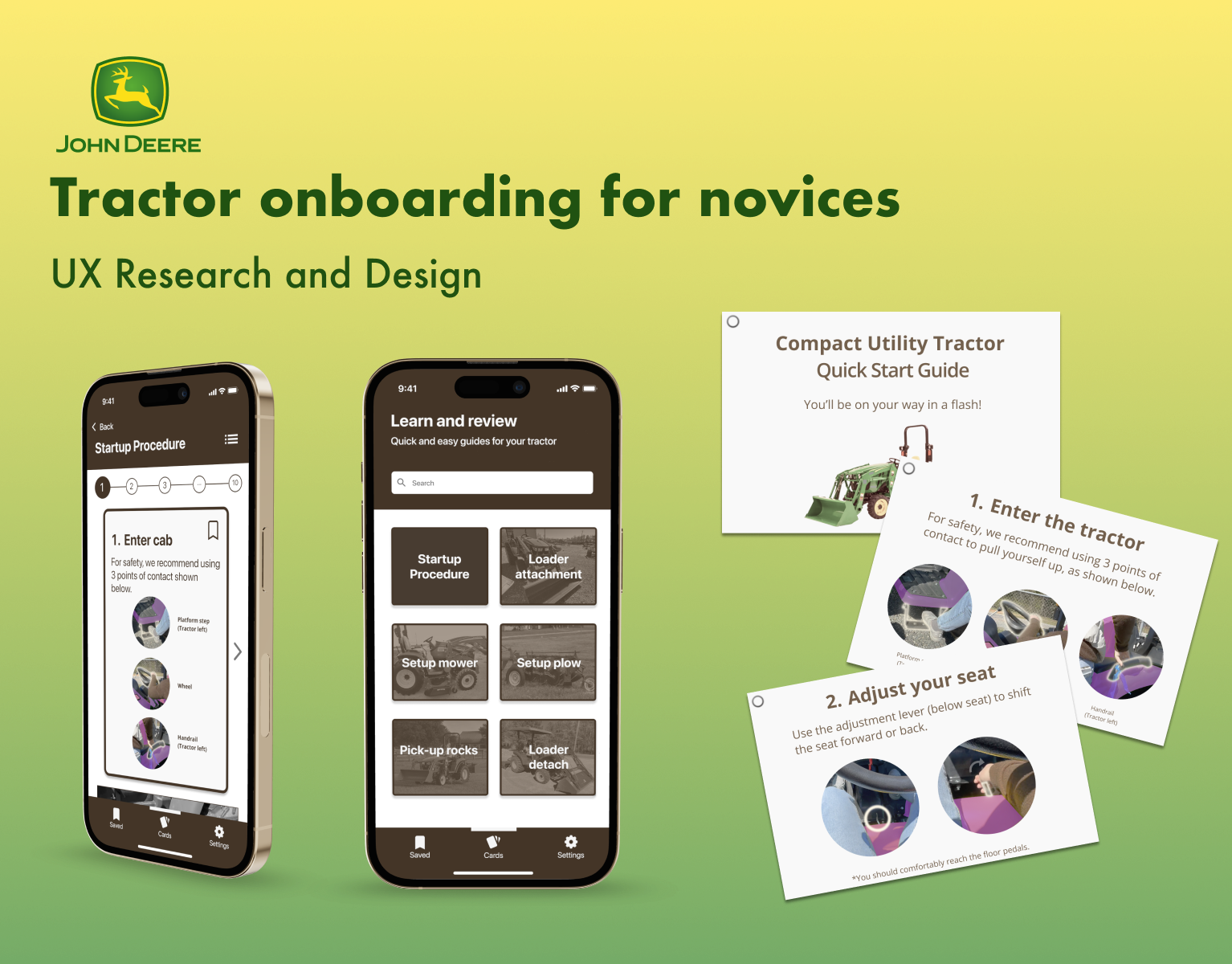Problem Overview
Recycling and repurposing computer parts is a challenge in our current society, especially with the accelerated increase in the PC gaming industryy. The significant increase over the pandemic is proportionally increasing the amount of electronic waste, or e-waste. Additionally, as more PC games are released with higher demands such as processing power and other requirements, gamers replace their PC hardware components without properly managing the old ones.
Project Goals
In our project, we explored ways to support sustainable methods and ways to reduce creating further waste.
My Roles
Lead UX Researcher and Strategist
Tools
Qualtrics XM
Miro
AutoCAD
Figma
Contributions
I conducted a literature review to understand and learn about the socio-cultural and technical context and challenges of recycling computer parts in the U.S. Also, I conducted field research and observation in electronics stores to understand their recycling and refurbishing options.
I also created screening surveys and conducted semi-structured interviews to understand users’ pain points. I analyzed the data from both methods. I collaborated with sketches for the web-app design and designed a medium-fidelity rendering recycle and donation space. I developed design evaluation protocols.
Timeline
August 2021-December 2021
Phase 1: Research
On initial research, we found literature regarding gamers, however, articles that focus on gamers’ sustainable habits are limited. Therefore, we used other online forums and resources that could give us a more current understanding of how the PC community manages their outdated or damaged computer parts. To gather more information, we conducted further investigation by visiting electronic equipment stores around the Atlanta area such as Micro Center and Best Buy to understand recycling and electronic waste management policies.
Additionally, we conducted an initial interview with a member of our target user group, PC gamers, who is a member of the e-sports club at an Atlanta university. We found that the information we gathered throughout this interview was insightful in better understanding PC gamers’ recycling habits and we will continue to explore our users and problem space through surveys, contextual inquiries, and interviews.
Competitive Analysis
Objective: To understand how different electronics stores currently take care of e-waste.
Rationale: Analyze the process and pain points of the users.
Methods: We investigated electronic stores' websites, marketplaces, Reddit forums, and current electronic recycling apps:
- eBay and Facebook Marketplace
- r/hardwareswap and r/buildapcsales
- Best Buy and Goodwill
- iRecycle
Findings
Field Research
Objective: get insights into the recycle site on PC parts recycling management and the experience as a user to go through that process.
Rationale: to understand the process, the user would have to go through recycled PC parts.
Methods: In-person site visit to Novus
Findings
-Most of the electronics that Novus receives are from institutions, while only about 2% of their inventory of items are from individuals.
-Each item has a different process. The crucial things are hard drives because they need to be wiped entirely, so no personal information is left.
-Novus separated each item into boxes and shipped them to another center to take care of the melt-down process.
-The warehouse is located in an industrial area which requires users to have a transportation method.
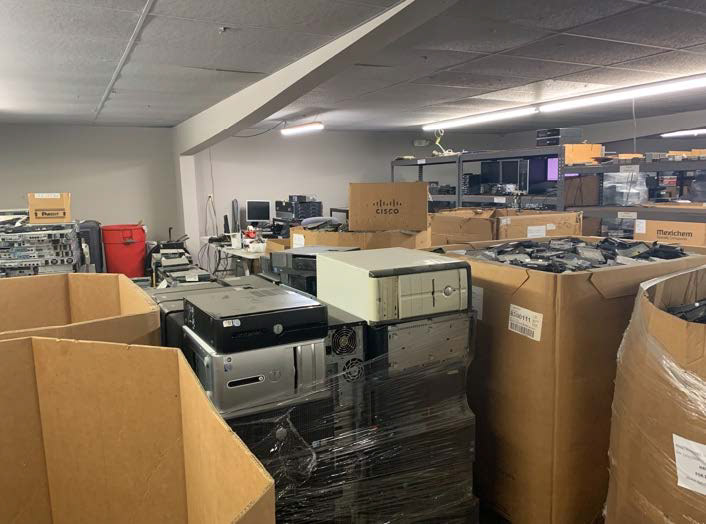
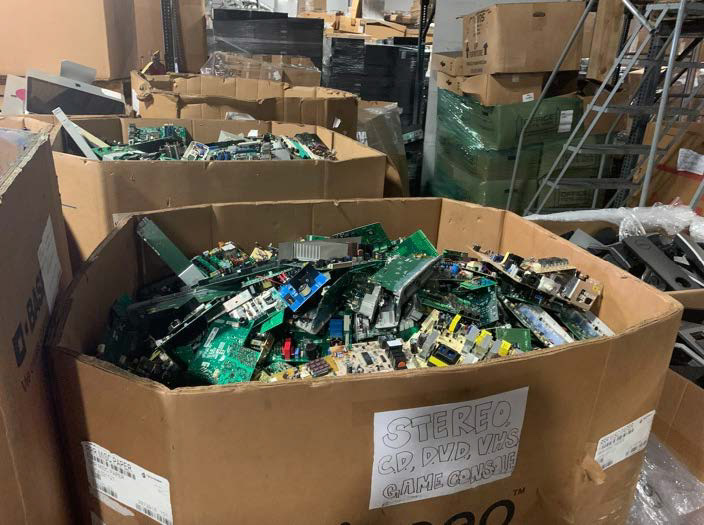
Surveys
Objectives: Gain information about PC gamers' demographics and recycling, reusing, and disposal habits. Screening and recruiting interview participants.
Rationale: The survey allows us to retrieve more information in a short period of time and help us prepare for further interviews.
Methods
- We developed a 20 questions survey using Qualtrics XM
- Distributed on five Discord servers
Data Analysis
We received 90 responses within seven days of distribution. Out of the 90 respondents, only 81 of them responded that they have built a gaming PC, we only counted their responses for the rest of our analysis.
Findings
-The majority of respondents indicated that they store the PC parts they don't need instead of selling, reusing, or recycling them.
- More than 50% of our respondents indicated that they bought their PC parts online.
-More than half of respondents prefer to buy new PC parts instead of refurbished ones.
Semi-Structured Interview
Objective: Understand users' attitudes and behaviors towards the process of getting rid of PC parts they no longer need.
Rationale: Semi-structured interview will allow us to ask follow-up questions to get a deeper understanding of their pain points and other insights.
Methods
- We conducted remote interviews using Zoom
- We analyzed themes from our notes through affinity mapping using Miro.
Data Analysis
To perform the affinity map, we entered our interview notes and transcripts into a spreadsheet. Then, we added them to Miro and created an affinity diagram. Individually, we walked the wall and brainstorm design ideas, then we came back together to discuss further implications. See below our diagram.
Findings/Insights
- We identified five core themes about PC gamers
Phase 2: Research to Design Requirements
Based on our research findings and insights, we came up with eight design requirements for our prototype:
Phase 3: Design
Design Idea
We brainstormed and sketched different ideas, and we decided on eCycle Hubs.
Context
There are two parts to the eCycleHub system, such as the physical drop-off location and digital service. eCycle Hubs will have partnered with community centers to be drop-off locations. The service will be near the users to reduce the barriers to getting rid of their PC parts. The digital service to donate and claim PC parts will be available on various devices, including mobile.
Additionally, we considered our user's mental context when using this service. We designed our service to be very simple and replicate a system that already exists so that it doesn't require extra effort to learn.
Prototype
For our high-fidelity prototype, we created three processes that the user would perform based on what they are trying to accomplish at the community center. Each process is listed below with a brief description and a button for the Figma prototype.
Recycling
The recycling functionality allows users to simply discard non-functioning PC parts into a bin to be properly disposed of. Items that are put into the bin would be picked up by electronic recycling companies and sorted at their individual warehouse. Users gain ePoints when they confirm that an item has been recycled!
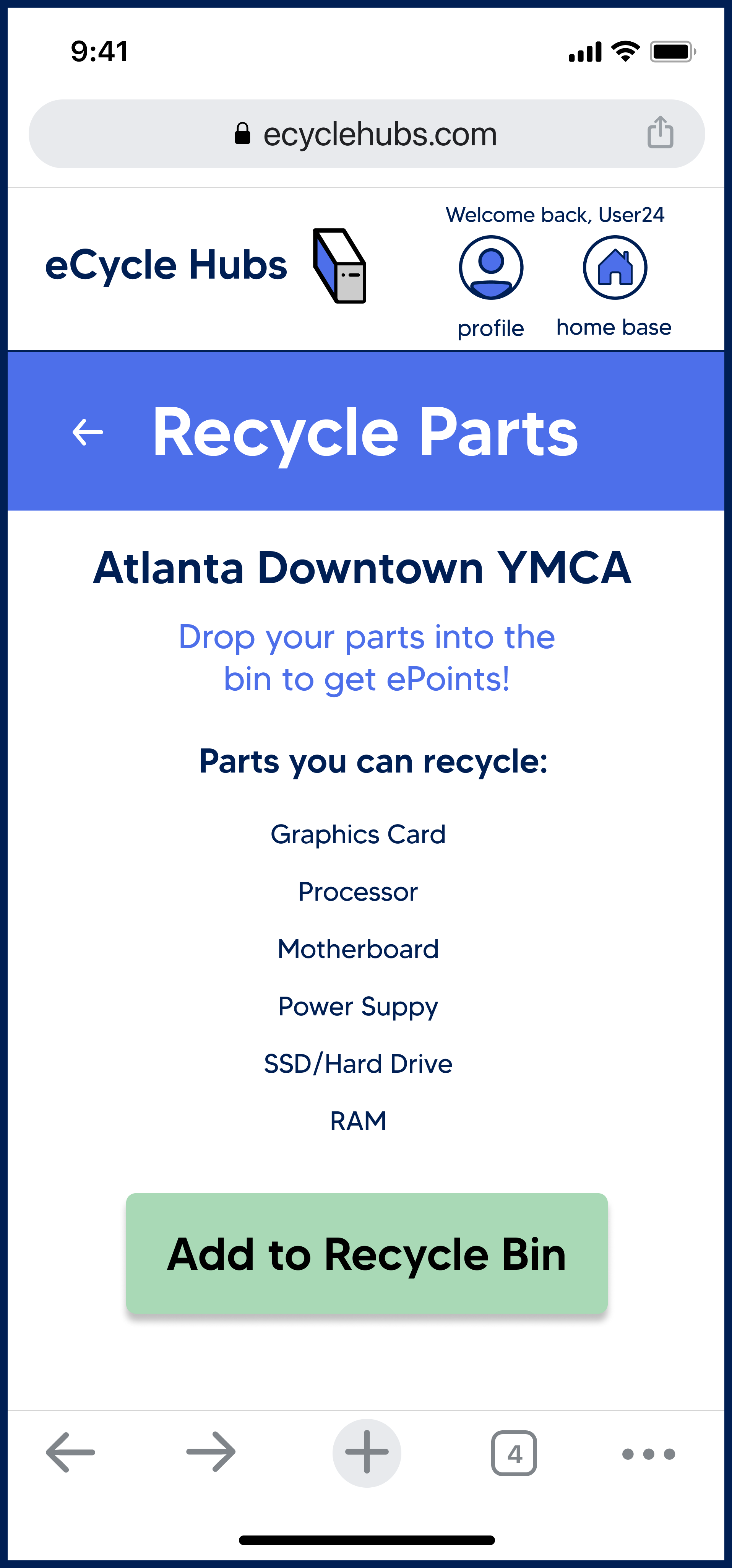
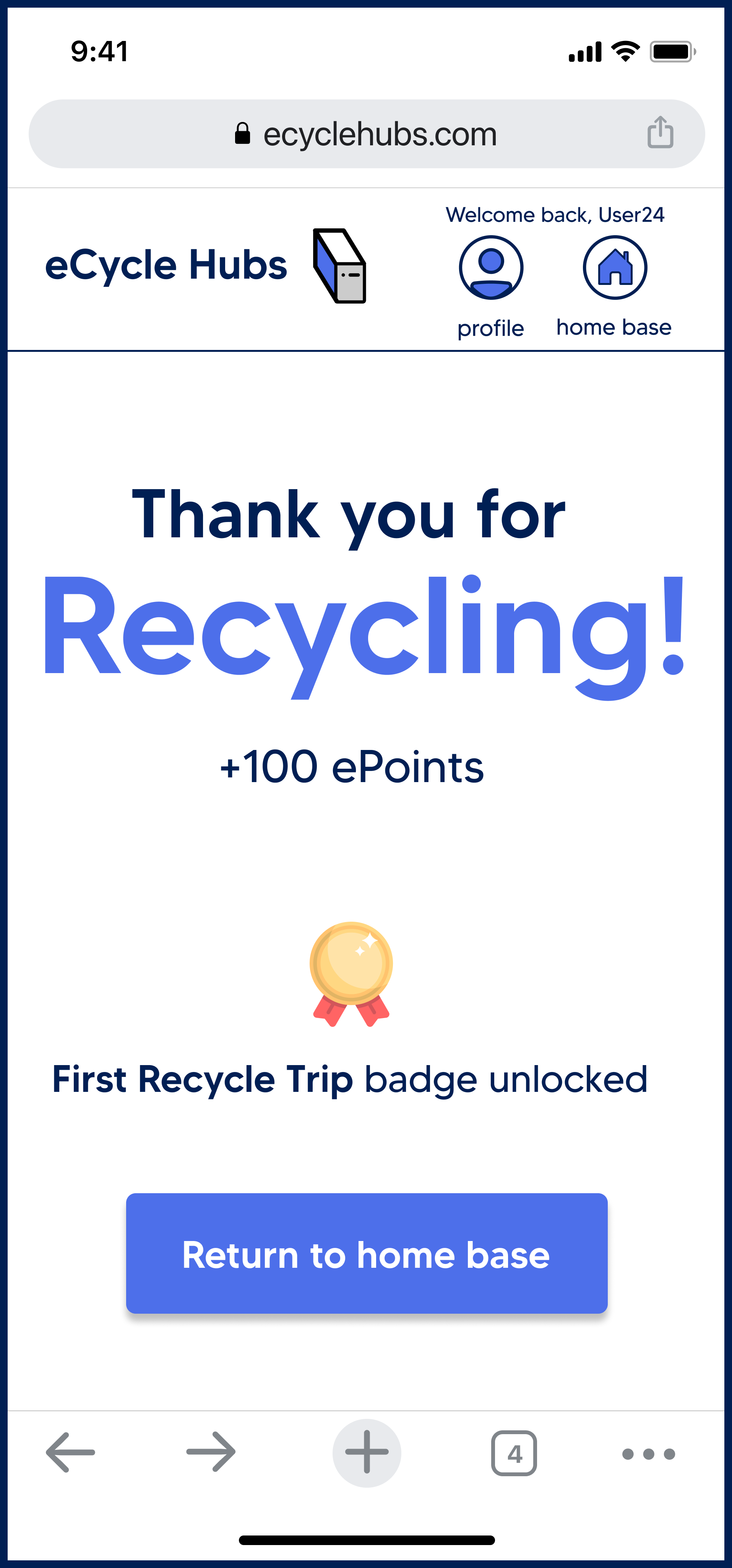
Donating
The donating functionality allows users to place unwanted (but still functional) items onto a shelf in the community center for others to come and claim at a later time. Key product data is input by the user who is donating to give an overall understanding of what the item is, the brand, any extra information about it, and what it looks like. Users gain ePoints when they confirm they have placed an item onto the donation shelf!
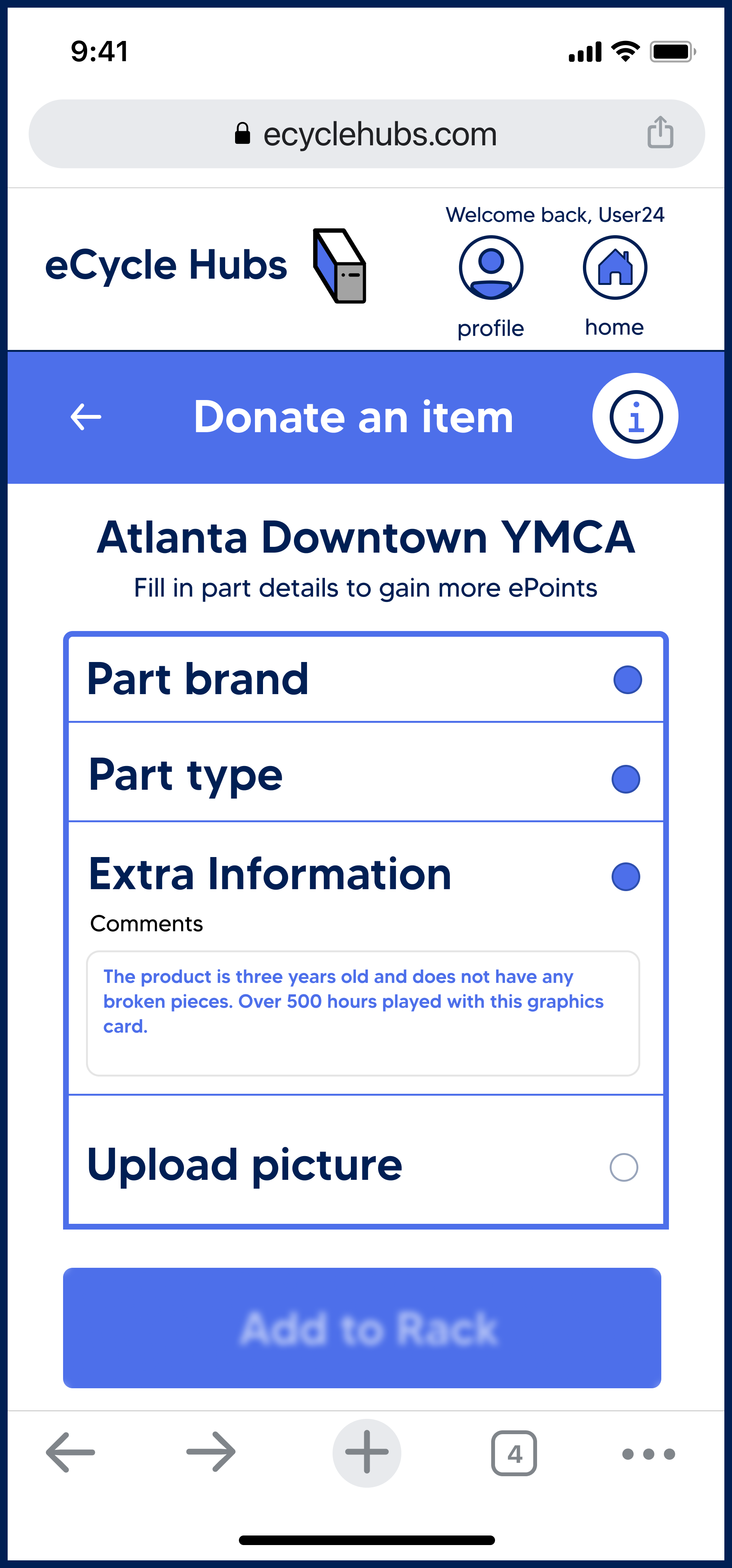

Claiming
The claiming functionality allows users to pick up parts that have been graciously donated by other eCycle Hubs users. Through a real-time inventory tracking system, the web app is able to keep an updated list of items that are currently on the shelf and ready to be claimed. A reservation process is optional if the user is unable to make it to the community center quickly and a 24-hour limit is attached to that specific item. Users gain ePoints when they confirm they have claimed an item!
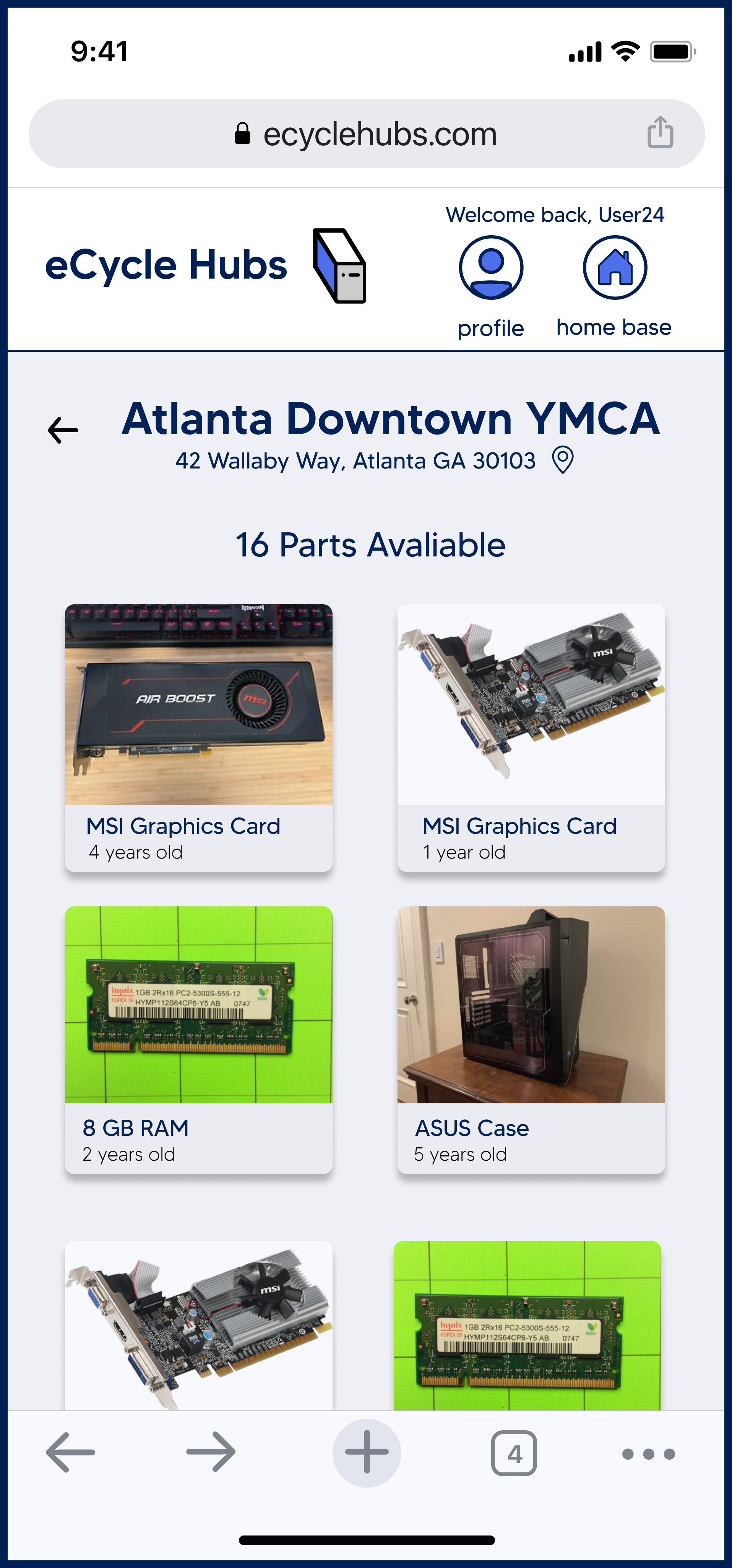
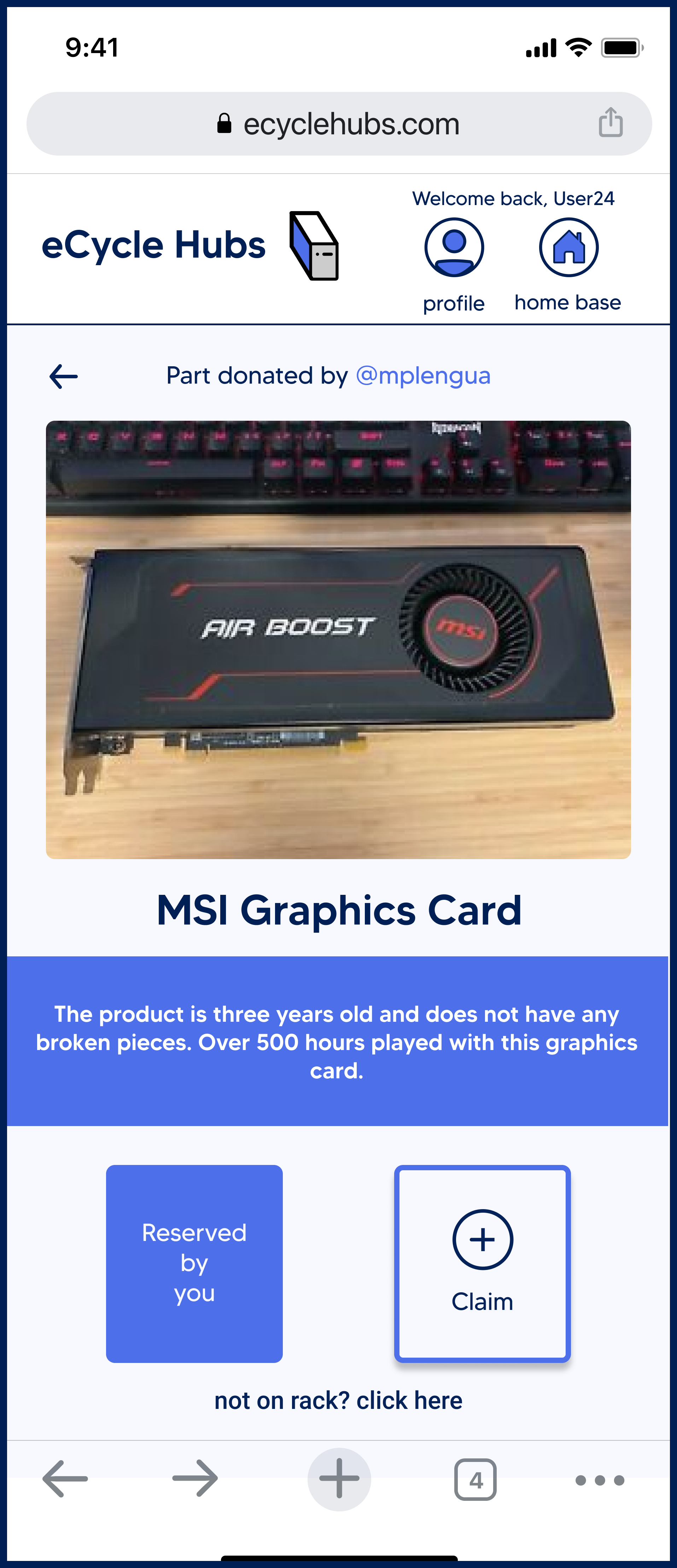
In addition, we design a rendering of how the physical eCycle Hubs recycle and donation space would look using AutoCAD and Adobe Photoshop
Phase 4: Design Evaluation
Discount Evaluation Plan
Due to the short-term timeline of this project for our discount evaluation we were required to select two design requirements to test with other teams from our class.
Evaluation Method Design Requirement #1
"The design should require little time and effort for the user."
We tested this requirement by performing a usability test with the goal to understand the time and success rate of users going through our prototype.
We gave our participants three core tasks that were pertinent to the core functionality of eCycle Hubs: recycling donating and claiming used items.
Evaluation Method Design Requirement #2
"The design should provide transparency and extensive information. "
We tested this requirement with follow-up questions after the usability test, and we also sent out a Likert scale questionnaire and a heuristic evaluation.
Data Analysis
For the first design requirement, we utilized Qualtrics automatic report to analyze the SUS questionnaire ratings. Also, we compared the completion time and success rates of tasks in a spreadsheet.
For the second design requirement, we also used Qualtrics automatic report system to analyze the responses from the Likert Scale and Heuristic Evaluation. We also identified common themes from follow-up questions responses using a spreadsheet.
Findings
We identified six themes from the discount evaluation:
Design Insights
After completing our design evaluation with participants in our graduate program, we identified multiple components to change in our prototype to enhance the experience for users.
Improved features included UX writing, button structure, and better detail organizing the labels of the PC parts.
Recommendations for similar systems
In general, prototypes related to this topic could be left more to someone's actions and conversations. For instance, a check-in system directly coordinated with each community center would decrease the use of electronic devices needed to complete a task. To illustrate, the users will not require input on the inventory section as in our current prototype.
Also, adding the check-in functionality will give more opportunities to implement a social aspect into the system. For example, a forum that would allow users to communicate.
Part of our findings from interviews indicated that PC gamers want to feel part of a community and have altruistic values with their peer gamers.
Users could appreciate the information given directly to them on building a new PC or updating the one they currently have. Based on our findings, another idea for future work is that there could be a voice option to the website. Users could chat directly with other users and the community center workers to ease the immediate communication process. Also, it will reduce the need for more UX writing and allow for open dialogue between users.


